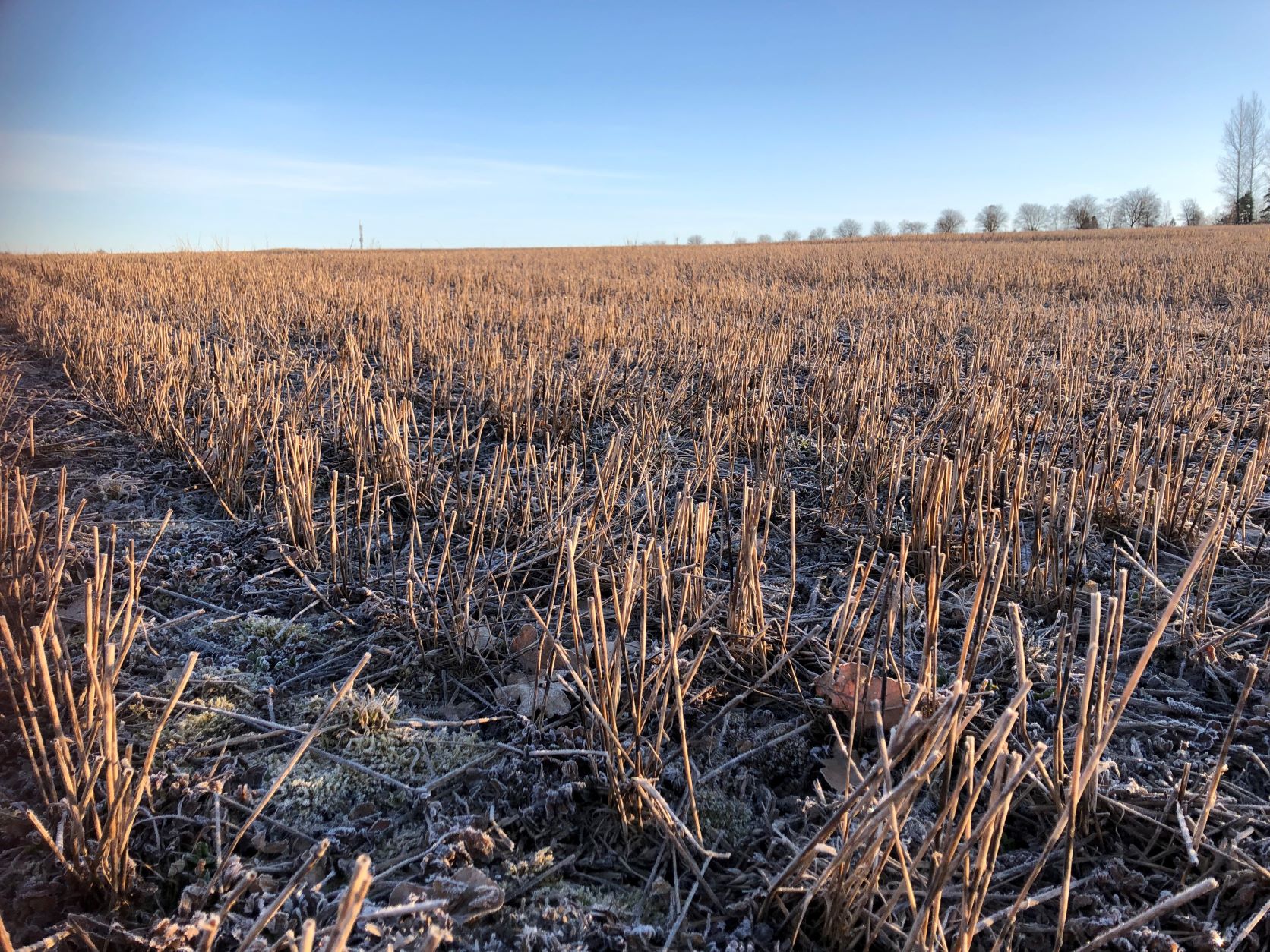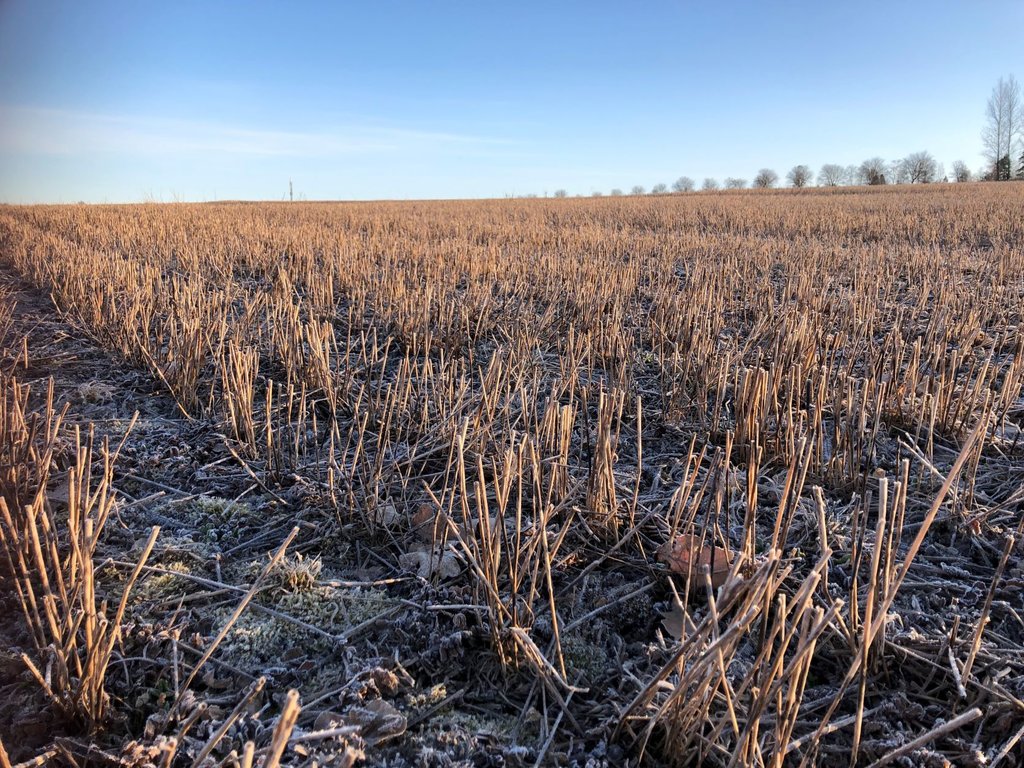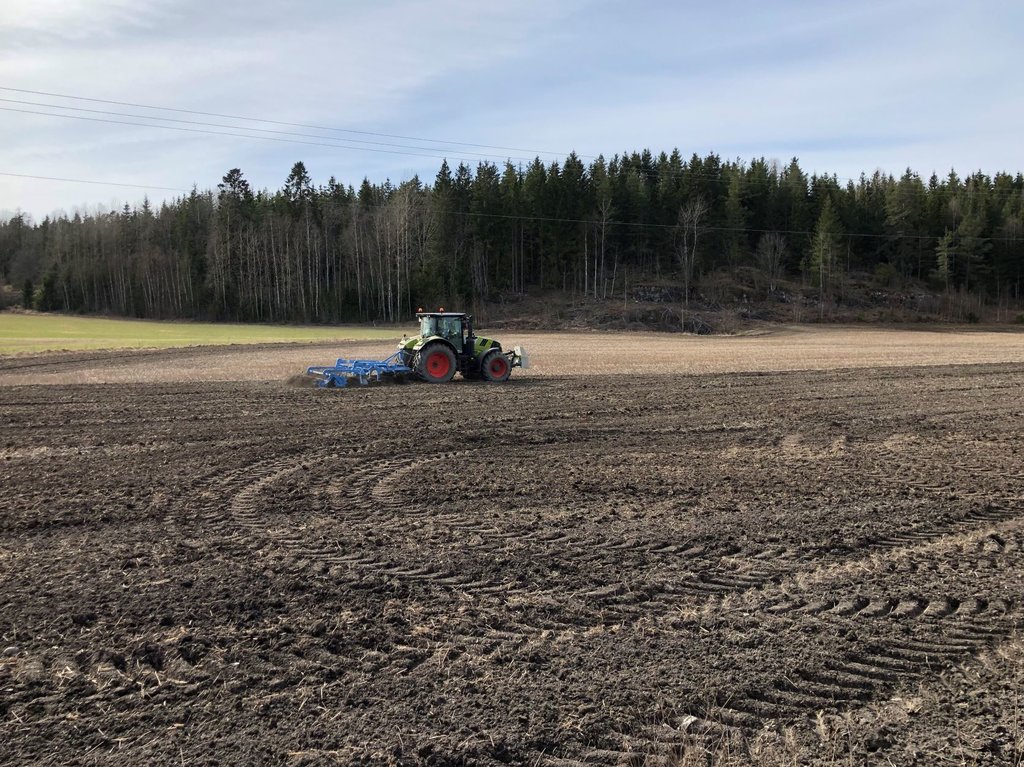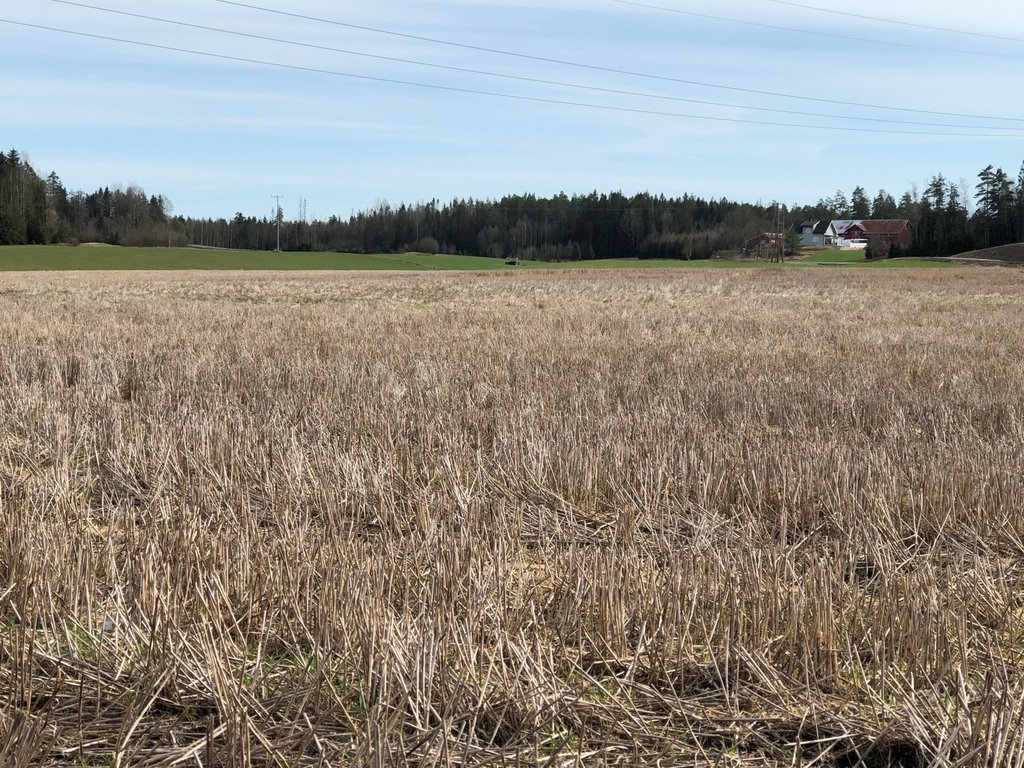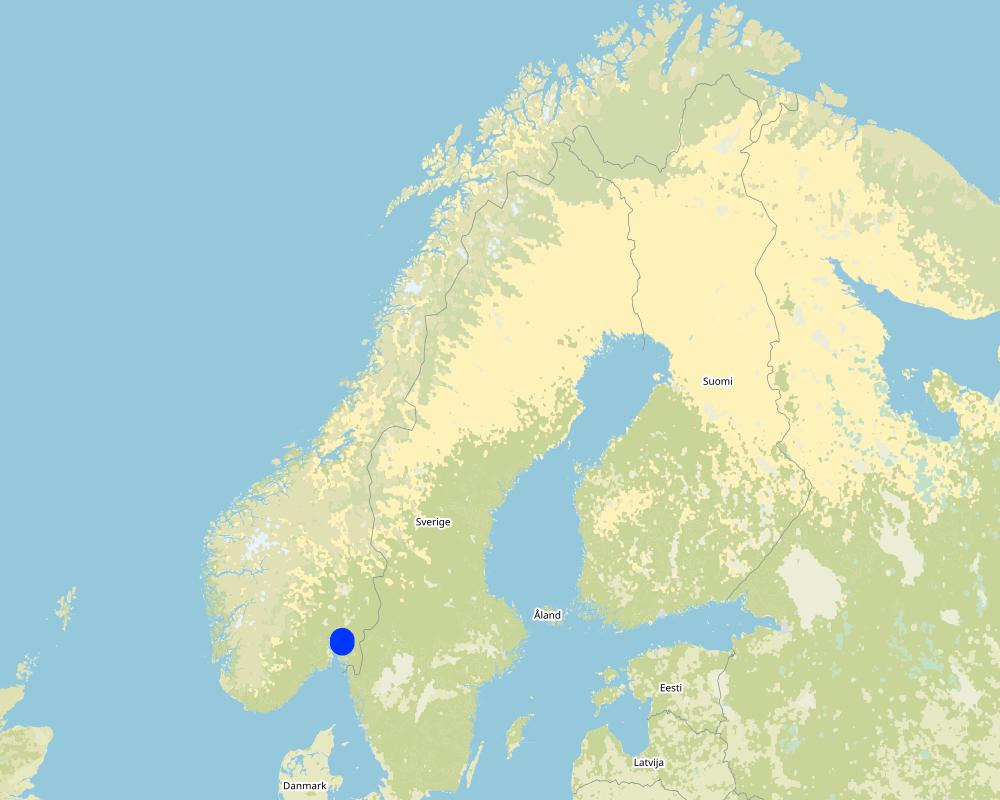Reduced tillage: no tillage in autumn [挪威]
- 创建:
- 更新:
- 编制者: Kamilla Skaalsveen
- 编辑者: Dominika Krzeminska, Lillian Øygarden
- 审查者: Alexandra Gavilano, William Critchley, Rima Mekdaschi Studer
Redusert jordarbeiding - ingen jordarbeiding om høsten
technologies_1245 - 挪威
查看章节
全部展开 全部收起1. 一般信息
1.2 参与该技术评估和文件编制的资源人员和机构的联系方式
SLM专业人员:
Bechmann Marianne
NIBIO
挪威
SLM专业人员:
SLM专业人员:
有助于对技术进行记录/评估的机构名称(如相关)
Norwegian Institute of Bioeconomy Research (NIBIO) - 挪威1.3 关于使用通过WOCAT记录的数据的条件
编制者和关键资源人员接受有关使用通过WOCAT记录数据的条件。:
是
1.4 所述技术的可持续性声明
这里所描述的技术在土地退化方面是否存在问题,导致无法被认为是一种可持续的土地管理技术?:
否
1.5 参考关于SLM方法(使用WOCAT记录的SLM方法)的调查问卷
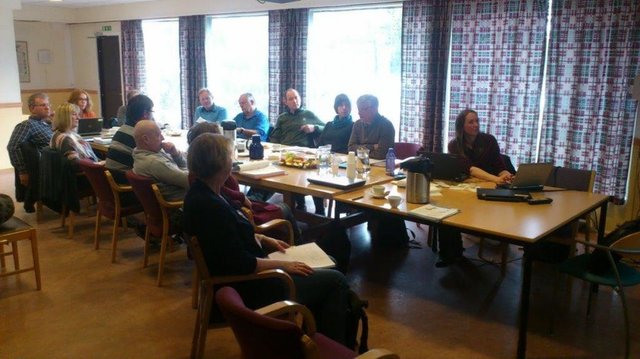
Regional Environmental program [挪威]
Regulations and financial grants for reduction of pollution and promotion of the cultural landscape.
- 编制者: Kamilla Skaalsveen
2. SLM技术的说明
2.1 技术简介
技术定义:
Reduced tillage, involving no plowing in the autumn, preserves stubble or plant cover during the autumn and winter to prevent soil erosion, and particle and nutrient loss from cropland to watercourses.
2.2 技术的详细说明
说明:
Purpose/aim: Reduced tillage (i.e., no tillage in autumn) is an efficient measure of preventing soil erosion, and particle and nutrient loss from cropland to watercourses. In addition to the protection of soil from water erosion, stubble fields contribute to increasing organic matter content, which may also increase the aggregate stability of the soil (in the upper soil layers). It is also possible that, as a result of this measure, higher biological activity may improve the soil structure.
Establishment/Maintenance: No tillage in autumn means that cropland areas are left as stubble fields after the harvesting is carried out and they remain like this throughout the winter.
It is of importance to keep in mind the potential for increased amounts of weeds and diseases (incl. fungi) when practicing this measure. The soil may also develop a rather dense structure over time if the climate is humid.
Natural / human environment: The information about Technology is based on the investigations and/or reports from different part of Norway.
For the purpose of the OPTAIN project (https://www.optain.eu/), the technology is further presented in the natural and human environment context of the Kråkstad River catchment - a Norwegian Case Study catchment within OPTAIN project.
The Kråkstad River is mainly situated in Ski municipality in South-Eastern parts of Norway. The river catchment is a western tributary of the Vansjø-Hobøl watercourse, also known as the Morsa watercourse. The Kråkstad River catchment area is c.a 51 km², 43% of which is agricultural land, where mostly cereals are produced on heavy clays soils. The main environmental challenge in the area is water quality (incl. high phosphorus pollution) and soil erosion (incl. riverbank erosion and quick-clay landslides). The Morsa watercourse is a drinking water resource and there are specific environmental regulations for land management followed by subsidies through the Regional Environmental Programme (RMP).
Special regulations in the Morsa catchment (https://morsa.org/) recommend that tillage, and fertilizer additions, are postponed to the start of March at the earliest.
2.3 技术照片
2.5 已应用该技术的、本评估所涵盖的国家/地区/地点
国家:
挪威
区域/州/省:
Viken county
有关地点的进一步说明:
The Vansjø - Hobøl catchment
具体说明该技术的分布:
- 均匀地分布在一个区域
如果不知道精确的区域,请注明大致覆盖的区域:
- 10-100 平方千米
技术现场是否位于永久保护区?:
否
Map
×2.6 实施日期
如果不知道确切的年份,请说明大概的日期:
- 10-50年前
2.7 技术介绍
详细说明该技术是如何引入的:
- 通过项目/外部干预
- Regional Environmental Programme (RMP)
注释(项目类型等):
The traditional soil tillage method until 1990 was autumn ploughing. From 1991 subsidies (RMP) were given for reduced autumn tillage and during the
period from 1990 to 2002 the autumn ploughed area was reduced from 82% to 43% of the cereal area (Bechmann, 2015). In 2009 about 53% of the grain area
was tilled in spring (Snellingen-Bye et al., 2010). In 2019 about 42% of the grain area was left in stubble during winter (Bjørlo et al. 2021).
Reference:
Bechmann, M., Collentine, D., Gertz, F., Graversgaard, M., Hasler, B., Helin, J., Jacobsen, B., Rankinen, K. and Refsgaard, K. 2016 Water management for agriculture in the nordic countries. Background document for NJF seminar 487. NIBIO report 2/2/2016.
Snellingen, Bye, A. and Løvberget, A. 2010. Landbruksteljing 2010. Statistisk sentralbyrå Rapport 2014/5.
3. SLM技术的分类
3.1 该技术的主要目的
- 减少、预防、恢复土地退化
- 结合其他技术保护流域/下游区域
- 适应气候变化/极端天气及其影响
3.2 应用该技术的当前土地利用类型
同一土地单元内混合使用的土地::
否

农田
- 一年一作
年作 - 具体指明作物:
- 谷类 - 其他
- small grains
每年的生长季节数:
- 1
具体说明:
Longest growing period in days: 135Longest growing period from month to month: May 1 to mid-September
3.3 由于技术的实施,土地使用是否发生了变化?
由于技术的实施,土地使用是否发生了变化?:
- 否(继续问题3.4)
3.4 供水
该技术所应用土地的供水:
- 雨养
3.5 该技术所属的SLM组
- 最小的土壤扰动
3.6 包含该技术的可持续土地管理措施

农艺措施
- A1:植被和土壤覆盖层
- A2:有机质/土壤肥力
- A3:土壤表面处理
A3:区分耕作制度:
A 3.2: Reduced tillage (> 30% soil cover)
注释:
Main measures: agronomic measures
Type of agronomic measures: minimum tillage
3.7 该技术强调的主要土地退化类型

土壤水蚀
- Wt:表土流失/地表侵蚀
- Wg:冲沟侵蚀/沟蚀

水质恶化
- Hp:地表水水质下降
注释:
Main type of degradation addressed: Wt: loss of topsoil / surface erosion
Secondary types of degradation addressed: Wg: gully erosion / gullying, Hp: decline of surface water quality
Main causes of degradation: soil management, heavy / extreme rainfall (intensity/amounts), governance / institutional
Secondary causes of degradation: deforestation / removal of natural vegetation (incl. forest fires), disturbance of water cycle (infiltration / runoff), change of seasonal rainfall, floods, land tenure
3.8 防止、减少或恢复土地退化
具体数量名该技术与土地退化有关的目标:
- 防止土地退化
- 减少土地退化
注释:
Main goals: prevention of land degradation
Secondary goals: mitigation / reduction of land degradation
4. 技术规范、实施活动、投入和成本
4.1 该技术的技术图纸
技术规范(与技术图纸相关):
not available
4.2 有关投入和成本计算的一般信息
具体说明成本和投入是如何计算的:
- 每个技术区域
注明尺寸和面积单位:
daa of arable land
如果使用本地面积单位,注明转换系数为1公顷(例如1公顷=2.47英亩):1公顷=:
10 daa
其它/国家货币(具体说明):
NOK
如相关,注明美元与当地货币的汇率(例如1美元=79.9巴西雷亚尔):1美元=:
8.89
注明雇用劳工的每日平均工资成本:
1440
4.3 技术建立活动
| 活动 | 时间(季度) | |
|---|---|---|
| 1. | no tillage in autumn | autumn |
注释:
No initial investment
4.4 技术建立所需要的费用和投入
注释:
No initial investments
4.5 维护/经常性活动
| 活动 | 时间/频率 | |
|---|---|---|
| 1. | no tillage in autumn | autumn |
4.6 维护/经常性活动所需要的费用和投入(每年)
如果土地使用者负担的费用少于100%,请注明由谁负担其余费用:
Under the RMP system (Regional Environmental Programme ) farmers can apply for subsidies for changed tillage practices. The subsidies are paid after erosion risk class.
注释:
The measure does not lead to any additional expenses for the land user.
However, land users indicate the need for consequent Increased usage of pesticides and reduced production. Subsidies for reduced tillage should compensate for negative effects and costs.
4.7 影响成本的最重要因素
描述影响成本的最决定性因素:
The measure does not lead to any additional expenses for the land user.However, land users indicate the need for consequent Increased usage of pesticides and reduced production.
Under the RMP system (Regional Environmental Programme in agriculture) farmers can apply for subsidies for changed tillage practices. The level of subsidy are based on erosion risk of the area. Depending on erosion risk class, farmer is entitled to ca. 20-200 kr/daa when implementing reduced autumn tillage (RMP for 2019-2022). In exposed watersheds, like those used for drinking water supply (e, g Vansjø- Hobøl catchment) farmers are obliged to implement stricter management practices to receive production support. The farmers in these catchments get higher subsidies than those in other catchments (Bechmann et al. 2016)
5. 自然和人文环境
5.1 气候
年降雨量
- < 250毫米
- 251-500毫米
- 501-750毫米
- 751-1,000毫米
- 1,001-1,500毫米
- 1,501-2,000毫米
- 2,001-3,000毫米
- 3,001-4,000毫米
- > 4,000毫米
指定年平均降雨量(若已知),单位为mm:
829.00
有关降雨的规范/注释:
The mean annual precipitation in Hobøl catchment is 829 mm (e.g., Skarbøvik and Bechmann, 2010). Large differences in water discharge are observed at the Hobøl River (Skarbøvik et al., 2014): from relatively stable discharge (1.0–3.0 m3/s) in winter and summer periods, to dynamically changing high discharge (7.0–48.0 m3/s) in spring and autumn.
农业气候带
- 半湿润
- 半干旱
Thermal climate class: temperate
Thermal climate class: boreal
5.2 地形
平均坡度:
- 水平(0-2%)
- 缓降(3-5%)
- 平缓(6-10%)
- 滚坡(11-15%)
- 崎岖(16-30%)
- 陡峭(31-60%)
- 非常陡峭(>60%)
地形:
- 高原/平原
- 山脊
- 山坡
- 山地斜坡
- 麓坡
- 谷底
垂直分布带:
- 0-100 m a.s.l.
- 101-500 m a.s.l.
- 501-1,000 m a.s.l.
- 1,001-1,500 m a.s.l.
- 1,501-2,000 m a.s.l.
- 2,001-2,500 m a.s.l.
- 2,501-3,000 m a.s.l.
- 3,001-4,000 m a.s.l.
- > 4,000 m a.s.l.
5.3 土壤
平均土层深度:
- 非常浅(0-20厘米)
- 浅(21-50厘米)
- 中等深度(51-80厘米)
- 深(81-120厘米)
- 非常深(> 120厘米)
土壤质地(表土):
- 中粒(壤土、粉土)
- 细粒/重质(粘土)
土壤质地(地表以下> 20厘米):
- 中粒(壤土、粉土)
- 细粒/重质(粘土)
表土有机质:
- 中(1-3%)
如有可能,附上完整的土壤描述或具体说明可用的信息,例如土壤类型、土壤酸碱度、阳离子交换能力、氮、盐度等。:
Soil fertility is medium-high
Soil drainage/infiltration is poor, need artificial drainage
Soil water storage capacity is very low-low
5.4 水资源可用性和质量
地下水位表:
< 5米
地表水的可用性:
好
水质(未处理):
仅供农业使用(灌溉)
水质请参考::
地下水和地表水
水的盐度有问题吗?:
否
该区域正在发生洪水吗?:
是
5.5 生物多样性
物种多样性:
- 低
栖息地多样性:
- 低
5.6 应用该技术的土地使用者的特征
定栖或游牧:
- 定栖的
生产系统的市场定位:
- 混合(生计/商业)
- 商业/市场
非农收入:
- > 收入的50%
相对财富水平:
- 平均水平
- 丰富
个人或集体:
- 个人/家庭
机械化水平:
- 机械化/电动
性别:
- 女人
- 男人
土地使用者的年龄:
- 青年人
- 中年人
说明土地使用者的其他有关特征:
Land users applying the Technology are mainly common / average land users
Population density: < 10 persons/km2
Annual population growth: < 0.5%
10% of the land users are rich and own 10% of the land.
90% of the land users are average wealthy and own 90% of the land.
5.7 应用该技术的土地使用者使用的平均土地面积
- < 0.5 公顷
- 0.5-1 公顷
- 1-2 公顷
- 2-5公顷
- 5-15公顷
- 15-50公顷
- 50-100公顷
- 100-500公顷
- 500-1,000公顷
- 1,000-10,000公顷
- > 10,000公顷
这被认为是小规模、中规模还是大规模的(参照当地实际情况)?:
- 中等规模的
5.8 土地所有权、土地使用权和水使用权
土地所有权:
- 个人,有命名
土地使用权:
- 个人
用水权:
- 自由进入(无组织)
5.9 进入服务和基础设施的通道
健康:
- 贫瘠
- 适度的
- 好
教育:
- 贫瘠
- 适度的
- 好
技术援助:
- 贫瘠
- 适度的
- 好
就业(例如非农):
- 贫瘠
- 适度的
- 好
市场:
- 贫瘠
- 适度的
- 好
能源:
- 贫瘠
- 适度的
- 好
道路和交通:
- 贫瘠
- 适度的
- 好
饮用水和卫生设施:
- 贫瘠
- 适度的
- 好
金融服务:
- 贫瘠
- 适度的
- 好
6. 影响和结论性说明
6.1 该技术的现场影响
社会经济效应
生产
作物生产
注释/具体说明:
There is a potential for increased amounts of weeds and diseases (incl. fungi) when practicing this measure.
生产故障风险
土地管理
收入和成本
农业收入
注释/具体说明:
Subsidies should compensate some costs
工作量
社会文化影响
SLM/土地退化知识
Improved livelihoods and human well-being
生态影响
水循环/径流
水质
地表径流
蒸发
土壤
土壤覆盖层
土壤流失
土壤压实
注释/具体说明:
The soil may also develop a rather dense structure over time if the climate is humid.
生物多样性:植被、动物
生物量/地上C
有益物种
6.2 该技术的场外影响已经显现
下游洪水
下游淤积
对公共/私人基础设施的破坏
对场外影响(测量)的评估进行具体说明:
Major land use problems (compiler’s opinion): Erosion, flooding and landslides, eutrophication of rivers and lakes
Major land use problems (land users’ perception): Increased usage of pesticides and reduced production
6.3 技术对渐变气候以及与气候相关的极端情况/灾害的暴露和敏感性(土地使用者认为的极端情况/灾害)
渐变气候
渐变气候
| 季节 | 增加或减少 | 该技术是如何应对的? | |
|---|---|---|---|
| 年温度 | 增加 | 好 | |
| 季雨量 | 秋季 | 增加 | 好 |
气候有关的极端情况(灾害)
气象灾害
| 该技术是如何应对的? | |
|---|---|
| 局地暴雨 | 好 |
| 局地风暴 | 好 |
气候灾害
| 该技术是如何应对的? | |
|---|---|
| 干旱 | 好 |
水文灾害
| 该技术是如何应对的? | |
|---|---|
| 比较和缓的(河道)洪水 | 好 |
其他气候相关的后果
其他气候相关的后果
| 该技术是如何应对的? | |
|---|---|
| 延长生长期 | 好 |
6.4 成本效益分析
技术收益与技术维护成本/经常性成本相比如何(从土地使用者的角度看)?
短期回报:
轻度消极
长期回报:
轻度消极
注释:
There are no establishment costs.
Subsidies paid after erosion risk are supposed to cover for negative effects and costs for maintenance (e.g for increased pesticide use, lower yield )
6.5 技术采用
- 11-50%
在所有采用这项技术的人当中,有多少人是自发的,即未获得任何物质奖励/付款?:
- 0-10%
注释:
There is no trend towards spontaneous adoption of the Technology.
Local regulations determine that farmers only receive subsidies per production area along with financial grants if they implement the technology.
6.6 适应
最近是否对该技术进行了修改以适应不断变化的条件?:
否
6.7 该技术的优点/长处/机会
| 土地使用者眼中的长处/优势/机会 |
|---|
| Reduced soil loss and erosion |
| 编制者或其他关键资源人员认为的长处/优势/机会 |
|---|
| Reduced soil loss and erosion |
| Reduced eutrophication of rivers and lakes |
6.8 技术的弱点/缺点/风险及其克服方法
| 土地使用者认为的弱点/缺点/风险 | 如何克服它们? |
|---|---|
| Increased usage of pesticides | |
| Reduced production |
| 编制者或其他关键资源人员认为的弱点/缺点/风险 | 如何克服它们? |
|---|---|
| Higher demand for pesticides | Autumn and spring harrowing |
7. 参考和链接
7.1 信息的方法/来源
- 根据报告和其他现有文档进行编译
(现场)数据是什么时候汇编的?:
07/02/2022
7.2 参考可用出版物
标题、作者、年份、ISBN:
Water management for agriculture in the nordic contries. Bechmann et al. 2016. NIBIO report 2/2/2016
可以从哪里获得?成本如何?
www.nibio.no
标题、作者、年份、ISBN:
Norwegian policy and practices regarding mitigation measures in agriculture. 2016. NIBIO POP 2(21) 2016.
可以从哪里获得?成本如何?
www.nibio.no
标题、作者、年份、ISBN:
Soil Tillage and Crop Growth Effects on Surface and Subsurface Runoff, Loss of Soil, Phosphorus and Nitrogen in a Cold Climate. Benchmann and Bøe 2021. Land 2021, 10(1), 77
可以从哪里获得?成本如何?
https://www.mdpi.com/
7.3 链接到网络上的相关信息
标题/说明:
Water management for agriculture in the nordic contries. Bechmann et al. 2016. NIBIO report 2/2/2016
URL:
https://nibio.brage.unit.no/nibio-xmlui/handle/11250/2382641
标题/说明:
Norwegian policy and practices regarding mitigation measures in agriculture. 2016. NIBIO POP 2(21) 2016.
URL:
https://nibio.brage.unit.no/nibio-xmlui/bitstream/handle/11250/2387569/NIBIO_POP_2016_2_21.pdf?sequence=3&isAllowed=y
标题/说明:
Soil Tillage and Crop Growth Effects on Surface and Subsurface Runoff, Loss of Soil, Phosphorus and Nitrogen in a Cold Climate. Bechmann and Bøe 2021. Land 2021, 10(1), 77
URL:
https://www.mdpi.com/2073-445X/10/1/77
7.4 一般注释
no remarks
链接和模块
全部展开 全部收起链接

Regional Environmental program [挪威]
Regulations and financial grants for reduction of pollution and promotion of the cultural landscape.
- 编制者: Kamilla Skaalsveen
模块
无模块


